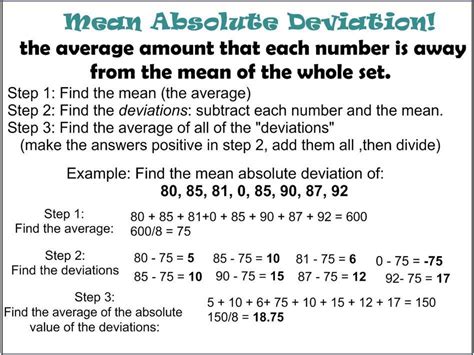How to Calculate MAD: A Simple Guide to Mean Absolute Deviation
Understanding how to calculate the Mean Absolute Deviation (MAD) is crucial for anyone working with data analysis, statistics, or forecasting. MAD provides a measure of the variability or dispersion of a dataset, indicating how spread out the data points are around the mean. Unlike standard deviation, MAD is easier to understand and calculate, making it a valuable tool for various applications. This guide will walk you through the process step-by-step.
What is Mean Absolute Deviation (MAD)?
The Mean Absolute Deviation represents the average distance between each data point and the mean (average) of the dataset. It's a way to quantify how much the individual data points deviate from the central tendency. A lower MAD suggests data points are clustered closely around the mean, while a higher MAD indicates greater dispersion.
Why use MAD instead of Standard Deviation?
While standard deviation is a commonly used measure of dispersion, MAD offers some advantages:
- Easier to understand and calculate: The calculation process for MAD is simpler and more intuitive, making it accessible to a wider audience.
- Less sensitive to outliers: Extreme values (outliers) have a less dramatic effect on the MAD compared to the standard deviation.
Calculating the Mean Absolute Deviation: A Step-by-Step Guide
Let's break down the calculation process with a simple example. Suppose we have the following dataset representing the daily sales of a small business:
10, 12, 15, 18, 20
Step 1: Calculate the Mean
First, we need to find the mean (average) of the dataset. This is done by summing all the values and dividing by the number of values:
(10 + 12 + 15 + 18 + 20) / 5 = 15
The mean is 15.
Step 2: Calculate the Absolute Deviations
Next, we calculate the absolute deviation of each data point from the mean. The absolute deviation is simply the absolute difference between each data point and the mean. Remember, we use the absolute value (ignoring the sign) to ensure all deviations contribute positively to the overall measure of dispersion.
- |10 - 15| = 5
- |12 - 15| = 3
- |15 - 15| = 0
- |18 - 15| = 3
- |20 - 15| = 5
Step 3: Calculate the Mean of the Absolute Deviations
Finally, we calculate the mean of these absolute deviations. We sum up all the absolute deviations and divide by the number of data points:
(5 + 3 + 0 + 3 + 5) / 5 = 3.2
Therefore, the Mean Absolute Deviation (MAD) for this dataset is 3.2. This means, on average, the daily sales deviate from the mean by 3.2 units.
Applications of MAD
MAD finds application in various fields, including:
- Finance: Assessing the risk of an investment by measuring the volatility of returns.
- Quality Control: Monitoring the consistency of a manufacturing process.
- Forecasting: Evaluating the accuracy of forecasting models.
- Meteorology: Analyzing weather patterns and predicting future weather conditions.
Improving Your SEO with MAD Calculations
Understanding and using MAD effectively can improve your SEO efforts in several ways:
- Keyword Research: Analyzing search volume data to identify keywords with less competition (lower MAD of search volume over time).
- Website Performance: Tracking website metrics and identifying areas for improvement. A lower MAD in bounce rate or page load time indicates better performance.
- Content Strategy: Analyzing content engagement metrics (e.g., time on page, shares) to optimize content performance.
By mastering the calculation and application of MAD, you'll gain valuable insights into your data and significantly improve your decision-making process, both in data analysis and in optimizing your online presence.
